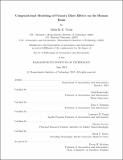Computational modeling of primary blast effects on the human brain
Author(s)
Nyein, Michelle K. (Michelle Kyaw)
DownloadFull printable version (3.078Mb)
Other Contributors
Massachusetts Institute of Technology. Department of Aeronautics and Astronautics.
Advisor
Raúl Radovitzky.
Terms of use
Metadata
Show full item recordAbstract
Since the beginning of the military conflicts in Iraq and Afghanistan, there have been over 250,000 diagnoses of traumatic brain injury (TBI) in the U.S. military, with the majority of incidents caused by improvised explosive devices (IEDs). Despite the urgent need to understand blast-induced TBI in order to devise strategies for protection and treatment, much remains unknown about the mechanism of injury, the effects of personal protective equipment (PPE) such as helmets, and injury metrics and thresholds. In order to help address these gaps, this thesis has four objectives: 1) to present a comprehensive computational framework for investigating the mechanical response of the human head to blasts that includes blast-structure interaction codes, a detailed, three-dimensional model of a human head generated from high-resolution medical imaging data, and an experimentally-validated constitutive model for brain tissue; 2) to validate the framework against a broad range of experiments, including free-field blast tests involving physical human head surrogates and laboratory-scale shock tube tests involving animals and human cadavers; 3) to use the computational framework to investigate the effect of PPE on the propagation of stress waves within the brain following blast events and evaluate their blast protection performance; and 4) to develop interspecies scaling laws for the blast response of the brain that would allow translation of injury metrics from animals to humans.
Description
Thesis (Ph. D.)--Massachusetts Institute of Technology, Dept. of Aeronautics and Astronautics, 2013. This electronic version was submitted and approved by the author's academic department as part of an electronic thesis pilot project. The certified thesis is available in the Institute Archives and Special Collections. Cataloged from department-submitted PDF version of thesis. Includes bibliographical references (p. 155-167).
Date issued
2013Department
Massachusetts Institute of Technology. Department of Aeronautics and AstronauticsPublisher
Massachusetts Institute of Technology
Keywords
Aeronautics and Astronautics.